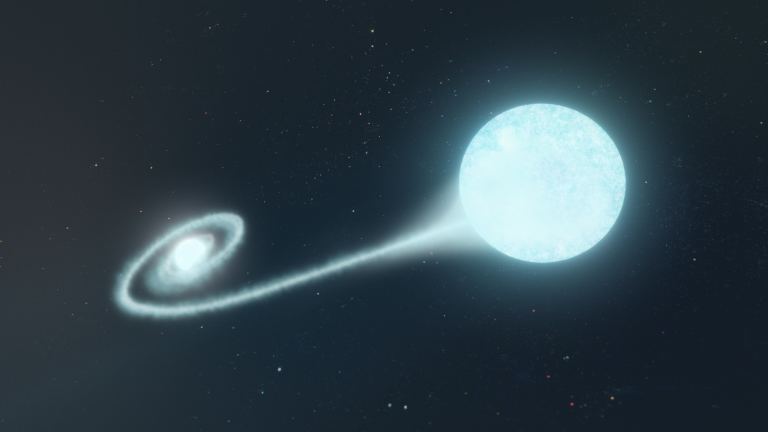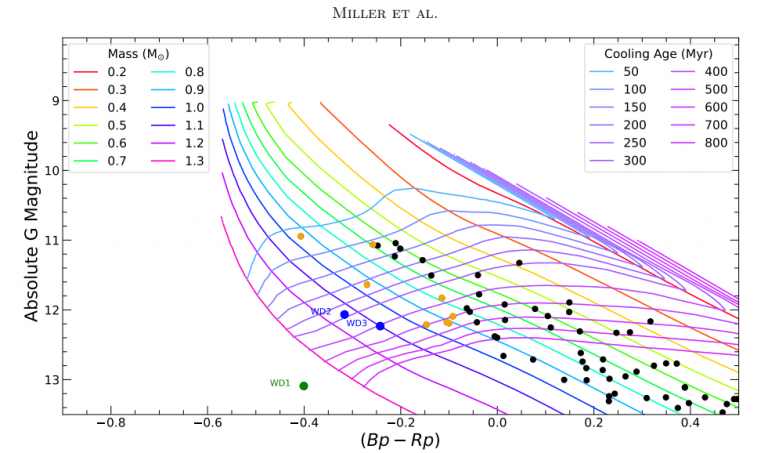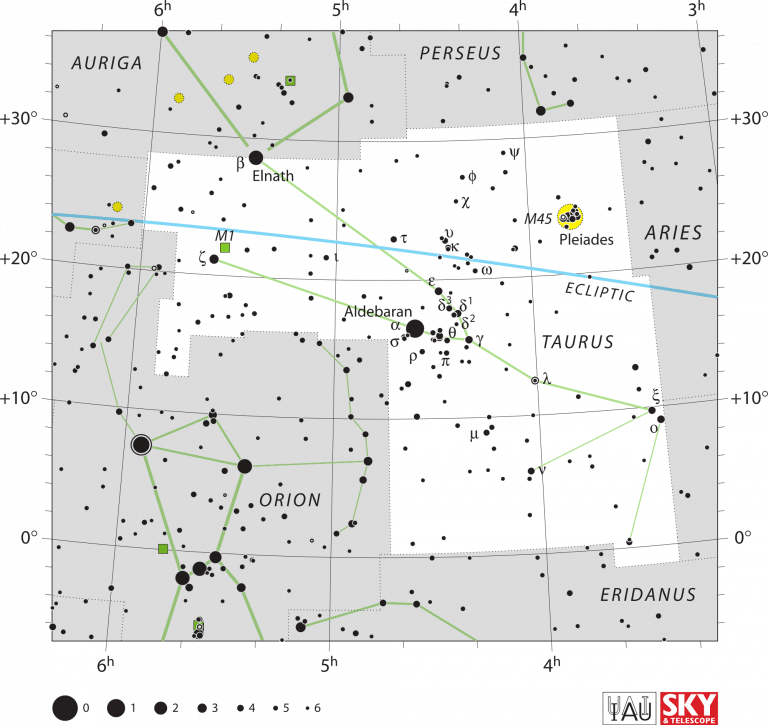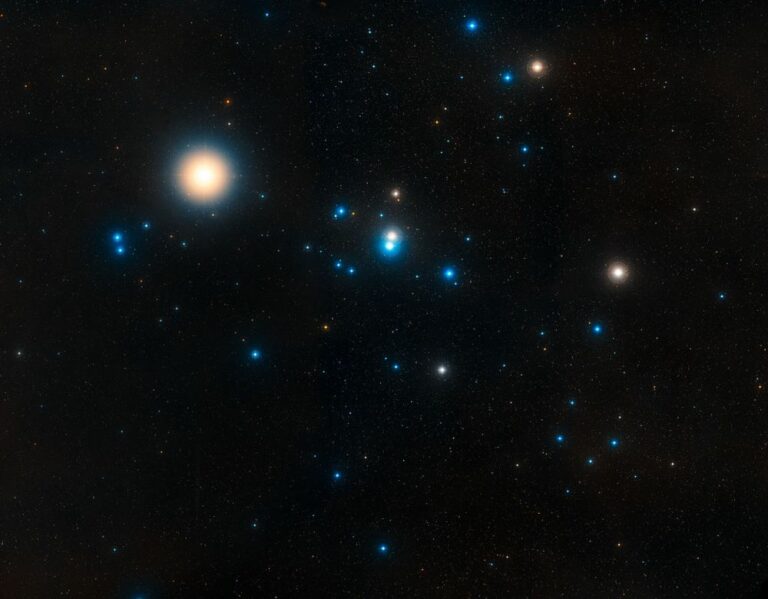The Nearest Star Cluster Ejected an Exceptionally Massive White Dwarf
“The Hyades Star Cluster, located a mere 153 light-years away in the Taurus constellation, presents a unique advantage for professional astronomers due to its proximity. This proximity allows for easier observations compared to other celestial objects of interest. The Hyades cluster comprises hundreds of stars that share common characteristics such as age, approximately 625 million years, similar metallic compositions, and similar motions through space.
However, a notable peculiarity within the Hyades cluster is the conspicuous absence of white dwarf stars. In its core, only eight white dwarfs are observed, which raises the question of their whereabouts. This scarcity of white dwarfs in the Hyades Cluster poses a perplexing challenge in our understanding of this celestial assembly.
Nonetheless, the Hyades Cluster, despite its unremarkable nature, serves as a crucial benchmark for astronomers studying star clusters. It stands as a curious anomaly due to its limited count of white dwarfs. Recent research has unveiled the discovery of an ultra-massive white dwarf that was expelled from the cluster. This white dwarf approaches the mass limit characteristic of this type of stellar remnant. The presence of this extraordinary white dwarf raises intriguing questions about its role and significance within the Hyades Cluster.”
The recent research bears the title “Escape of an Exceptionally Massive White Dwarf from the Hyades Star Cluster” and has been submitted for publication in The Astrophysical Journal. The lead author of this study is David Miller, hailing from the Department of Physics and Astronomy at the University of British Columbia.
Open clusters like the Hyades are characterized by their loose binding, resulting in the gradual loss of stars over time due to interactions with gas clouds, other stellar clusters, and intra-cluster encounters. Miller and his team conducted a thorough investigation into the dearth of white dwarfs within the Hyades cluster as a means to reconstruct the cluster’s history. Identifying stars, particularly white dwarfs, that have been expelled from the cluster assists in piecing together its evolutionary journey.
The European Space Agency’s Gaia spacecraft played a pivotal role by meticulously tracking over one billion stars within the Milky Way, thereby providing Miller and his colleagues with an extensive data repository to explore. Within this data, the researchers discovered three ultra-massive white dwarfs displaying kinematics suggesting that they may have originated from the Hyades cluster. While the mass range of two of these white dwarfs made it improbable that they belonged to the Hyades, the third one showed a strong likelihood of being an escapee from the cluster, as stated by the authors.
White dwarfs, although as massive as the Sun, possess dimensions comparable to the Earth. Comprised of electron degenerate matter, they have exhausted their fusion energy long ago, emitting only residual thermal energy.
White dwarfs represent the end-stage for approximately 97% of the stars in the Milky Way. Governed by the Chandrasekhar Limit, they can possess a maximum mass of approximately 1.44 times that of the Sun. Should they accumulate additional mass, typically by siphoning it from a binary companion, they reach a critical point and explode as Type 1a supernovae, releasing their entire mass into the cosmos.

The white dwarf that has escaped from the Hyades cluster is classified as an ultra-massive white dwarf, a category reserved for those with a mass of 1.10 solar masses or more. This mass range falls below the Chandrasekhar limit but significantly exceeds the typical mass of an average white dwarf, which is around 0.6 solar masses. Such ultra-massive white dwarfs represent noteworthy anomalies in the field of astrophysical white dwarf studies. Typically, high-mass white dwarfs originate from binary systems where one white dwarf accrues material from its companion, thus increasing its mass.
However, the Hyades ultra-massive white dwarf defies this trend with a mass of 1.317 solar masses and an age that aligns with a single progenitor. This makes it a potential record-holder as the most massive white dwarf to have emerged from a single progenitor. Additionally, it stands as the most substantial single progenitor star strongly linked to an open cluster.
The researchers note that, assuming a formation pathway based on single-star evolution, there is a 97.8% likelihood that this candidate is a genuine escapee from the Hyades.
The significance of this otherwise unremarkable star lies in the fact that the creation of such a massive white dwarf typically necessitates a binary system where one star syphons material from the other. This discovery serves as a pivotal observational reference point, demonstrating that single stars can indeed yield white dwarfs with masses closely approaching the Chandrasekhar limit, as elucidated by the researchers in their study.

While the Hyades cluster may appear unimpressive in various aspects, its proximity to Earth allows astronomers to discern and analyze older, cooler white dwarfs with greater precision, thus enabling them to meticulously trace the origins of these stars. This unique advantage provided by the Hyades cluster’s unassuming characteristics has permitted the research team to conduct an in-depth study. Given the cluster’s unremarkable nature, the findings of this study can, to some extent, be extrapolated to open clusters in general.
In the authors’ concluding remarks, they highlight how the unremarkable attributes of the Hyades cluster, combined with its proximity, suggest that open star clusters may be more frequently responsible for producing ultramassive white dwarfs, some of which approach or surpass the Chandrasekhar limit, than previously believed.
Locating the Hyades cluster in the night sky is relatively straightforward. It can be easily identified as Orion’s Belt points directly towards it. For those interested in observing it, the best viewing opportunities occur from Northern Latitudes during the months of November, December, and January. When observed with the naked eye, it forms a distinctive “V” shape composed of approximately 20 stars, and this count can be augmented to around 100 stars when employing binoculars.

Do not forget to share your opinion with us to provide you with the best posts !





0 Comments